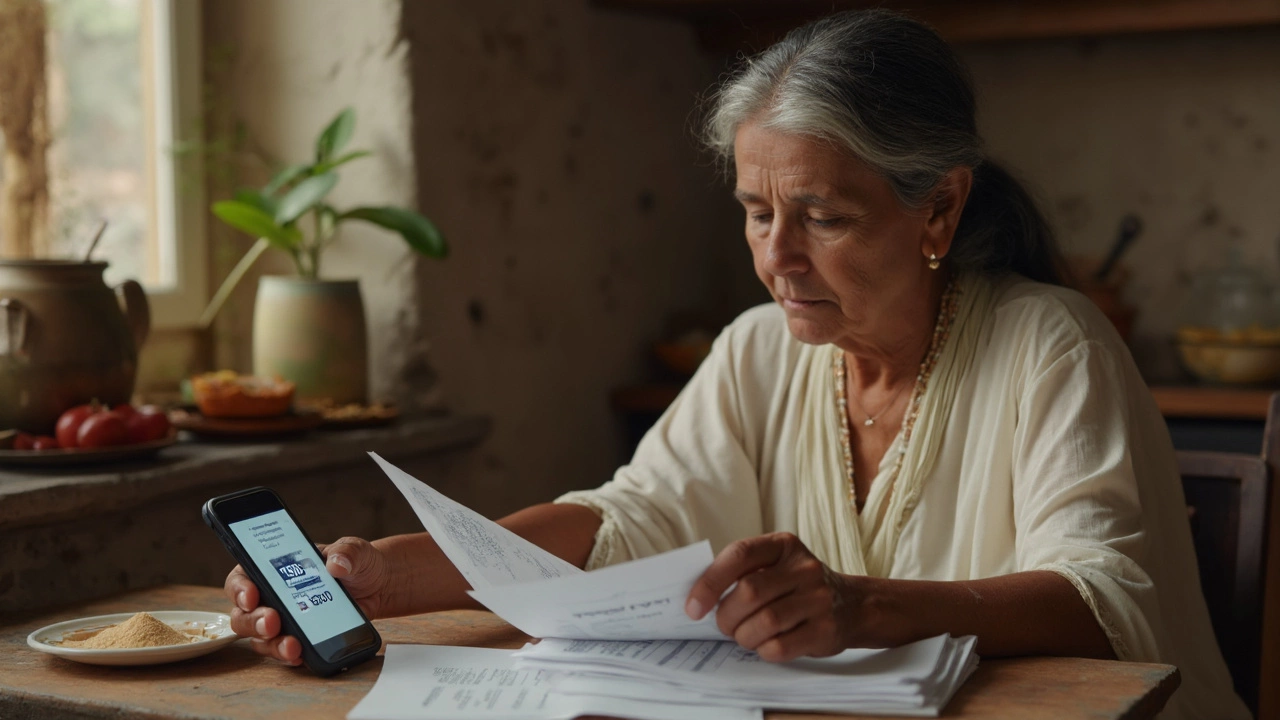Rumors about a $900 grocery stimulus for seniors have been everywhere lately, but is this offer real or just another internet rumor? This article digs into where the idea comes from, what help is actually out there for older adults struggling with grocery bills, and how to spot misleading scams. We'll spotlight real programs that offer food support and share practical tips for saving money on groceries. Stay informed to make sure you're getting real help—not empty promises.

- Created by: Lydia Carmichael
- Completed on: 23 Apr 2025
- Categories: Elderly Support
Scrolling social media or glancing at your inbox, you've probably spotted eye-catching headlines: '$900 Grocery Stimulus for Seniors – Apply Now!' Sounds pretty great, right? But if your gut says something feels off, trust it.
Before getting your hopes up, let’s dig into what’s actually available. Sure, food prices are wild lately, and a lot of folks—especially those on a fixed income—are searching for real support. That’s made the promise of a big check for groceries even more tempting. But is there such a thing as a $900 grocery stimulus just for seniors?
If you're hunting for reliable ways to cut costs on groceries or hoping there’s legit help out there, you're in the right spot. We'll look at the origin of this viral claim, break down what real programs offer, and show you how to spot scams before they steal your time (or your info).
- Where Did the $900 Grocery Stimulus Rumor Start?
- What Official Sources Say About Grocery Stimulus
- Real Food Assistance Programs for Seniors
- Avoiding Scams: What to Watch Out For
- Tips for Stretching Your Grocery Budget
Where Did the $900 Grocery Stimulus Rumor Start?
The buzz about a grocery stimulus for $900 has exploded online in the last year. It started popping up just after the pandemic, mostly on Facebook, Twitter, and in email newsletters aimed at older adults. You’ll often see flashy headlines or ads that shout about new seniors benefits you can “claim now,” sometimes even using big official-looking logos or fake quotes from politicians.
If you follow these links, they rarely go anywhere official. They often send you to websites packed with pop-up ads or ask you to share your personal info—things like your name, address, or even Social Security number. It’s fishy, and for good reason: According to the Federal Trade Commission, reports of senior scams jumped 47% between 2021 and 2023, with many scams promising easy cash or benefits.
This $900 promise seems to be an offshoot of older rumors about stimulus money from the government. Yes, there were real stimulus payments sent out during COVID-19, but nothing specifically for groceries and nothing targeting seniors with that exact amount. A few scam websites twist real programs—like the Supplemental Nutrition Assistance Program (SNAP) or one-time relief checks—into something they’re not, hoping folks don’t see the fine print.
Here’s a typical pattern with these rumors:
- Scam stories spread fast in Facebook groups or retirement forums
- Clicking the links brings you to fake news sites or survey pages
- They ask for personal info “to check eligibility” for the $900 offer
- Your data ends up in spam sales lists, or worse, in the hands of scammers
The lesson? If you hear about a brand-new senior benefits program offering big bucks for groceries and you can’t find it on sites like usa.gov or through your local Area Agency on Aging, tread carefully. Real benefits are never handed out just by filling out a form on a random website.
What Official Sources Say About Grocery Stimulus
If you dig around on government websites or even call your local Social Security office, you won't find any official mention of a grocery stimulus just for seniors, especially not a lump-sum payout like $900. There’s no program from Social Security, Medicare, or the U.S. Department of Agriculture handing out money just to spend at the grocery store. It just doesn’t exist.
The USDA does have programs to help seniors with food costs—like the Supplemental Nutrition Assistance Program (SNAP), which loads money onto an EBT card each month. The average monthly SNAP benefit for senior households is a lot less than $900; for most seniors, it’s under $200. A special program called the Commodity Supplemental Food Program (CSFP) gives some seniors a box of groceries each month, but again, not cash. Here’s a quick look at what’s actually offered:
| Program | What It Gives | Typical Benefit |
|---|---|---|
| SNAP | Monthly funds for groceries on an EBT card | Around $195/month for senior households |
| CSFP | Monthly box of shelf-stable groceries | Food only, no cash |
| Social Security | Monthly income for eligible seniors | Varies, not just for groceries |
Sometimes Congress talks about stimulus checks, usually during emergencies like COVID-19, but nothing specific like a $900 benefit for groceries for older adults is on the books now. If you see offers that sound “too good to be true” (think: big grocery cash for clicking a random link), none of those are backed by any real agency.
- Check Social Security and USA.gov for news or legitimate benefits updates.
- Ignore messages urging you to “act fast” to claim a food stimulus. That's not how official help works.
- If a site asks for your Social Security number or bank info to get a $900 grocery stimulus, it’s likely a scam.
Staying sharp means using trusted sources and not letting viral stories or flashy headlines sidetrack you. Real help is out there—just not in the form that these grocery stimulus rumors promise.

Real Food Assistance Programs for Seniors
The idea of a one-time grocery stimulus check just for older adults isn't real, but there are several trustworthy programs designed to help seniors afford groceries every single month. These programs might not throw a big headline dollar amount your way, but for a lot of people, they cover way more than you'd think.
The most well-known option is probably SNAP—the Supplemental Nutrition Assistance Program. SNAP used to be called food stamps, and it’s run by the government. It's available in every state, with eligibility mainly based on your income and expenses. In 2024, the average senior got between $20 and $281 per month in SNAP benefits, but some folks get even more if they have higher essential costs. You use a card (it looks and works like a debit card) at most grocery stores, convenience stores, and even some farmers’ markets.
If you’re at least 60 and your budget’s tight, it’s worth checking if you qualify. Applications are online or through local social service offices. Some states even have coordinators who walk you through everything—no annoying paperwork puzzles alone.
Another helpful program is the Commodity Supplemental Food Program (CSFP). It’s not as widely known, but it delivers a monthly box of healthy staple foods just for people aged 60 or older who meet income limits. Think canned veggies, cheese, grains—basic stuff that helps you build meals. Community centers or local food banks usually handle sign-ups.
Here’s a quick side-by-side table showing two main programs:
| Program | Who Can Apply | What You Get |
|---|---|---|
| SNAP | Anyone meeting income guidelines (60+ get simpler rules) | Monthly dollars on a card for groceries |
| CSFP | People 60+ who meet stricter income limits | Monthly food box with basics like cheese, pasta, canned fruit |
Don’t forget about local food banks and senior centers, either. They often team up with national groups like Meals on Wheels to deliver free groceries or hot meals right to folks who can’t get out. Seniors can also check if stores in their area offer special senior days with discounts or free delivery.
It might take a few calls or online forms to get signed up, but these programs really can lower your monthly bills. If you need help with the paperwork, ask a librarian, social worker, or someone at your town’s senior center—these folks do this every day.
Avoiding Scams: What to Watch Out For
If you see ads promising a grocery stimulus or cash for food, be careful. There’s no official $900 grocery stimulus for seniors from the U.S. government or any real agency. Scammers know that seniors are worried about rising prices, and they’re using these fake programs to trick people out of money or personal info.
Most of these scams pop up online, often through email, social media, or pop-up ads. Some even create websites that look super official. They usually ask you to “apply now” and get you to share sensitive stuff like your Social Security number or bank account info. Don’t do it.
- If a site or email asks for your Social Security number, Medicare number, or bank details to “qualify,” it’s almost always a scam.
- Watch for messages filled with urgent language—things like “Act fast!” or “Limited time offer!” Scammers want you to panic and click without thinking.
- Check the sender’s email or the website URL. Government programs use addresses ending in .gov—not .com, .org, or anything weird.
- Don’t pay up front fees. Real help for seniors with groceries won’t make you pay money just to sign up or get information.
The Federal Trade Commission keeps getting reports about stimulus scams. In 2024 alone, Americans reported losing over $100 million to government stimulus fraud, and seniors are often the main targets. Here’s a quick comparison of how real programs and scams usually look:
| Real Program | Possible Scam |
|---|---|
| Doesn't ask for money up front | Charges a “processing fee” |
| Official .gov website | Odd website or odd email address |
| Clear eligibility rules | Vague promises for “everyone” |
| No need for private info right away | Demands Social Security or banking info |
If something seems off, double check with someone you trust—friend, family, or even your local senior center. You can always call the National Elder Fraud Hotline (866-347-3455) if you’re not sure. When it comes to your info and your money, it’s better to be extra cautious.

Tips for Stretching Your Grocery Budget
Let’s be real: most people aren’t seeing a magic grocery stimulus check, so knowing how to get the most from every dollar is huge—especially for seniors on a fixed income. No silver bullet here, but a few changes can make a real difference.
Start with your grocery list. According to the USDA, meal planning and shopping with a list can cut your food bill by up to 20%. Ditch those impulse buys—stores set up tempting displays for a reason.
- Stick to fresh basics: Beans, rice, eggs, oats, and frozen vegetables are usually cheaper and last longer than lots of brand-name packaged stuff.
- Watch the weekly ads: Stores like Kroger and Safeway run sales in cycles. You can stock up when your favorite things are at their lowest price.
- Sign up for loyalty programs: Those little cards or phone numbers at checkout actually do rack up points or discounts, even if they feel like a hassle.
- Buy store brands: Consumer Reports has tested generic versions and found they’re usually just as good as name brands—sometimes made by the same factories!
If you want to see where you can trim more, here’s a look at what seniors spend on groceries, according to a January 2024 AARP survey:
| Age Group | Average Groceries/Month |
|---|---|
| 60-69 | $325 |
| 70-79 | $270 |
| 80+ | $240 |
Try shopping earlier in the day, too—some grocery stores mark down bakery, meat, and produce that are still perfectly good, but need to move fast. And nobody benefits from deals on food that’ll go to waste, so only buy extra if you know you’ll use or freeze it.
You might be surprised by how helpful your local food pantry can be as well. These aren’t just for emergencies. Many pantries today offer weekly fresh produce, bread, and even meat—no questions asked. Check FoodPantries.org to find one near you.
Saving money at the store is hard work, and it’s perfectly normal to ask for help. Here’s what Melissa Williams, a community outreach coordinator, says:
“It’s not about the size of your budget—it’s about using every resource, from coupons to food banks. Seniors shouldn’t be shy about asking; these programs exist for a reason.”
So, whether you’re clipping coupons, hunting for sales, or reaching out for food assistance, every step helps. Stretching those dollars is a win, no matter your age.
Need help getting groceries? This guide explains how anyone can apply for help from a local food bank. You'll learn about eligibility, application steps, and what to expect during your first visit. Find out how food banks really work and get tips that make the process smoother. Clear answers for anyone worried about food insecurity.
